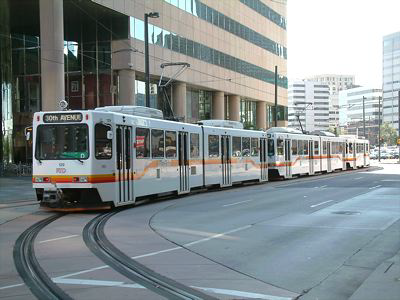No Light Rail in Vancouver!
Ho-

FasTracks, the $4.7 billion project that aimed to build six new rail transit lines
in the Denver metropolitan area, now looks like it will be a $6.5 billion project
at least. Transit agency documents obtained by the Denver Post reveal that the latest
cost estimates for every single rail line are an average of 64-

A light-
According to the Post, the overruns “include almost $1 billion in design and engineering, $345 million in construction materials, $56 million in the price of rail cars and nearly $600 million in unexplained “contingency” costs, among other elements.” RTD, the transit agency, says it thinks this is high, but agrees that the cost will definitely be higher than the 2004 estimates. (The numbers in the Denver Post story are in 2006 dollars, while the $4.7 billion total is in “year of expenditure” dollars.)
This is just another piece of evidence against the inane transportation planning being conducted by so many urban areas. This planning process is supposed to include the identification of a broad range of alternatives, a careful assessment of the benefits and costs of each alternative, and then selection of the “locally preferred alternative,” part of which may be funded with federal gas tax dollars.
In actual practice, cities make a token effort at best at considering alternatives. They typically greatly underestimate the costs and overestimate the benefits of rail transit when they compare those alternatives. Then, even when their analysis shows that rail transit is still the worst alternative, they pick it anyway.
Denver, for example, commissioned “major investment studies” of five of the proposed new rail lines. Required by US DOT, these studies typically compared new highways, bus routes, and rail transit. At the end of the major investment study, the cities drop all the alternatives except the one they prefer.
Denver’s studies all showed that rail transit was the least cost-
For example, in the East Corridor, which connects downtown Denver with the airport, the major investment study projected that new freeway lanes would do twice as much to relieve congestion as rail transit, yet cost considerably less. Of course, they decided to build rail transit anyway.
When RTD brought FasTracks to the voters, it had already increased the projected
costs of the rail lines (after adjusting for inflation) by nearly 60 percent. When
added to the recent cost overrun, we have a total increase of 160 percent above the
costs in the major investment study. The East Corridor line, for example, is not
expected to cost more than a billion dollars. This is significant because it was
after the major investment study that all non-
By comparison, though highways also suffer cost overruns, they tend to be much smaller. A study published in the Journal of the American Planning Association found that U.S. rail transit cost overruns averaged more than 40 percent while U.S. highway overruns averaged only 8 percent.
RTD is still early in its planning process: it does not expect to complete construction of the rail lines until 2017, meaning Denver taxpayers can look forward to ten more years of cost overruns.
One way RTD can deal with overruns is to delay completion of the rail lines. The
tax increase that it persuaded voters to approve has no sunset, and the financial
plan called for RTD to sell long-
RTD’s other recourse is to cut back on the rail plans, but this solution is fraught with political peril. The FasTracks plan was endorsed by most cities along the rail lines on the strict condition that RTD would build all the lines at once. City officials worried that, if it built some lines first and others later, cost overruns would prevent the completion of the later lines, and no city would agree to be on one of the later routes.
Voters have an alternative too. The measure approved in 2004 specifically allows voters to change their minds. Of course, someone will have to gather thousands of signatures to put a measure on the ballot reconsidering the project. That won’t be easy or cheap. But it would be cheaper in the long run than spending unknown billions of dollars on a rail transit system that would take more than a decade to build and that was obsolete five decades ago.
5
Trackback • Posted in Planning Disasters, Transportation, Urban areas
Reprinted from The Antiplanner
Cost Per Hour Saved, East Corridor
Cost Delay Hours Cost/
Alternative (millions) Saved Hour
New freeway lanes $305 61,200 $2.18
HOV/bus lanes 337 41,900 3.34
Commuter rail 374 29,700 7.12
Light rail 571 30,300 8.26